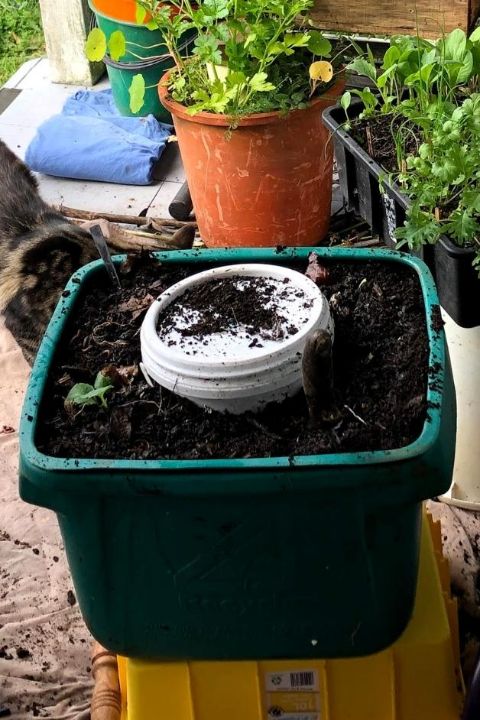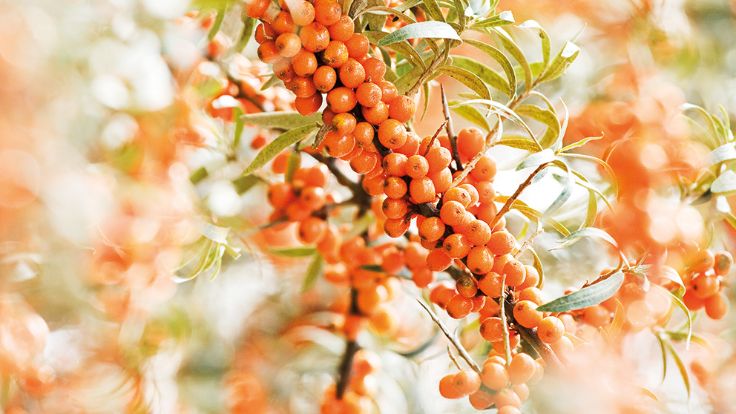
Family-Friendly Biodynamics - Winter
Winter Garden Ideas
A series of gardening tips with Katrina Wolff from Blue Borage
We often think of winter as a dormant time of year in the garden. Not much seems to be growing, and it’s so very cold that we all just want to be inside enjoying hot soup, nourishing casseroles and warm drinks. It’s a nice time of year to use the oven every day - not just to warm our stomachs, but to also warm our kitchens and our homes. This sense of using warmth to cook and to enliven our home is a deep-seated instinct.
What’s the equivalent in the garden?
Could it be that a hot compost pile is a little like the hearth?
Just as you wouldn’t design a house without a kitchen or an oven, it’s strange to see gardens designed without space for composting. Fortunately, there are some workarounds. Read below for some fun ideas to get you into your garden this winter.
Save Earth’s Skin
What can we do to care for the soil in winter? Regenerative, organic and biodynamic farmers plant cover crops, always keeping the soil covered with vegetation, like a blanket that feeds and protects the Earth.
As home gardeners, or city dwellers, we can help replenish the earth in winter by handling our food scraps with care. A lot of us pause our productive gardening through winter. It’s a nice change to take a rest from planting, digging, weeding and watering. But we don’t stop eating, so the collective mountains of food waste continues, no matter what the weather is like. What happens to all those apple cores, cabbage hearts, carrot tops, onion skins, and orange peels?
It’s tragic to think of most of them going to landfills, bagged up with other rubbish that will never turn to soil, the nutrients removed from our food system, and instead placing a burden on the Earth by way of deep caverns of toxic sludge that eventually get covered over and another landfill hole created - it’s a giant mess for future generations to clean up. We can, and we must do better.
Enliven imagination, Stand for truth, Feel responsibility
Here at Weleda we are committed to modelling the finest techniques of Earth Stewardship. More than regenerative, not just organic, we go one step further, and apply biodynamic methods in all our productive gardens. We love to share how to use these methods in your garden.
Imagine digging up a spade of soil: the most obvious sign of life is the worms. These tiny creatures are gently aerating and nourishing the soil beneath our feet. They may slow down when it’s cold, but are actively making soil all year round.
By digging into the subsoil, loosening it, and threading it with tunnels, earthworms gradually deepen the topsoil layer. By ripping up fine mineral particles and depositing them as castings on or near the surface of the soil, they are constantly adding nutrients to the zone in which plant roots feed, delivering mineral substances that would otherwise remain largely unavailable to most plants.
Composting worms are a little different to earthworms. Earthworms are the worms you find tunnelling underground when you dig a spadeful of soil up to plant a tree. The composting worms (such as tiger worms) are different: these worms eat food on the surface of the earth and leave behind worm castings (worm poop) which is like black gold in the garden. A small worm farm is a wonderful way to show children that food scraps really do turn into soil.
A Winter Worm Farm project
Install a small in-ground worm farm into a garden bed. You can make it out of a small plastic container, a piece of tubing like a downpipe, even a terracotta pot will work, so long as there is a hole in the bottom. Alternatively you can invest in a large worm farm system that will handle a whole family’s food scraps.
Advantages to in-ground worm farming:
- Minimal care - the liquid goes straight into your garden, acting as a natural fertiliser for your plants.
- The worms are able to travel in and out of the container, accessing food inside the worm farm, or finding the type of soil they prefer outside the worm farm. Worms come from the earth - we should have worm farms that mimic their natural environment as much as possible.
- Your plants will probably look and taste amazing with a worm farm next to them: crunchy, sweet, and when summer arrives, you’ll find they don’t need watering as much.
Disadvantages of in-ground worm farming:
- Small worm farms won’t process much waste - think of them more as pets, and not something to replace a huge compost bin. Please carry on with your cold composting, bokashi or support your local community garden by dropping off your food scraps for composting. ShareWaste and MakeSoil are two platforms that can help with decentralised food scrap composting.
Small worm farms are fussy - you won’t want to add ‘tricky’ things like meat, dairy, citrus, onions or bread to a little in-ground worm farm. Give them the easy material like apple cores and vegetable scraps, but cut them into little pieces for the most rewarding results.
Extra ideas for Gardening with Children
- If it’s not too cold to be outside in the garden, then you can keep on making hot compost piles. Seeing steam rising up off a hot compost pile on a cold day is remarkable, especially when the weather seems cold enough to stop anything from warming up.
- Adopt a log: this is a long term garden project. Find an interesting looking log and put it somewhere in your garden to study through the seasons. It will attract a few different bugs, and become a home for these creatures in your garden. Biodiversity is a good thing to encourage. Do a google search on ‘bug hotels’ to find lots of examples.
- You could be somewhere where it is just impossible to grow in the winter months. While resting your garden beds, you can give them a sort of winter blanket of goodness to break down slowly, so that by the time summer is here, you will have precious nutrients to blend in with your composting and worm farms. Things to add: seaweed, arborist mulch, manure from farm animals like cows, horses, sheep, chickens, alpacas, guinea pigs, rabbits.
- Tree paste: one of the winter tips in the Weleda book on Biodynamic Gardening is to apply tree paste to your fruit trees. Where compost is like a protective blanket for the Earth, tree paste is a sort of protective remedy for tree trunks. I bet it feels a bit like getting a face mask. “After emptying the vegetable plot, you put biodynamic compost back into the garden to make sure that the next set of crops grow in soil and subsoil filled with renewed italy. Tree paste is effectively the compost used for trees. It is spread on the outer bark and works on what is called the cambium - the growing layer between the bark on the outside and the tree trunk on the inside. The cambium is really the subsoil or root system for the tee’s shoots and leaves, and the paste provides a life-enhancing stimulus from the outside which makes the tree healthier within.”
- Make or use CPP (Biodynamic Cow Pat Pit preparation): For those who are still able to plant and grow food all year round, then a simple introduction to biodynamics is to use CPP regularly when transplanting seedlings or preparing new garden beds for planting. You simply stir the preparation in water for 20 minutes and then apply it to the soil. It’s also really lovely to give your houseplants a boost of vitality. CPP is made from cow manure, crushed egg shells, volcanic rock dust, and the six herbal biodynamic compost preparations (yarrow, chamomile, stinging nettle, dandelion, oak bark and valerian).
You don’t need to make your own CPP from scratch: you can purchase it from the Biodynamic Association of New Zealand, or contact them to see who in your region is making this at home or running workshops to learn the skill. https://biodynamic.org.nz/ - If you’re in a warm climate, then winter is a good time to dig up perennials and divide them. Here you can see a sorrel plant getting divided in half, to be potted up as a gift for a friend in spring.
- Plan your fruit tree pruning. If it’s still a bit early for you to start pruning your fruit trees, then you can study their shape and structure, and make some tactical decisions about where to cut. You could tie colourful ribbons to the spots where you’ll be making cuts, which will speed up the pruning task later.
Winter Garden Ideas - A checklist for home gardeners
Simple
- Upgrade your worm farm systems, or start an in-ground worm farm in an existing garden
- Grow microgreens as a winter leafy garnish
- Adopt a log and observe the way it breaks down in your garden
- Learn to make hot compost
- Put a 'winter blanket' of mulch over your garden beds while they rest
- Dig up perennial herbs to divide or use the roots
- Plan your pruning, tie some ribbons where you plan to cut
- Plan your spring garden and order seeds
- Gather materials to make your own potting mix: Compost, Leaf Mould, Worm Castings, Arborist mulch.
Complex
- Use CPP, the Cow Pat Pit preparation
- Make tree paste for your favourite trees
- Make a green waste management plan, and put all your garden waste to good use
- Make CPP, the Cow Pat Pit preparation
Social
Find a biodynamic workshop in your area and book yourself into a class or find out when the next community stir is happening.
What's happening in the Weleda garden?
Here at Weleda winter is really busy. We are harvesting a lot of the roots that are used in medicinal remedies. What looks like a dormant season is often just the life forces being more active under the ground, invisible to human eyes.
Finally, remember spring is just around the corner. It’s a good time to order seeds, repair any tools that need fixing, give your garden shed a good tidy up, and spend the wet days and long evenings learning the theory behind any new gardening methods you’d like to try this year.
Here at Weleda we are planning the opening of a visitor garden, and look forward to welcoming you into our space in spring so we can show you around in person.
Please join the Save Earth's Skin campaign to raise awareness of the importance of soil. Pick one of the suggestions above and enter the competition to win a $250 monthly prize pack on our pledge page here.



















